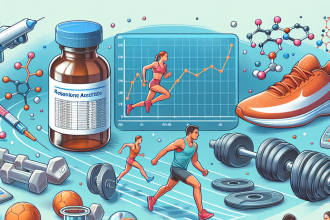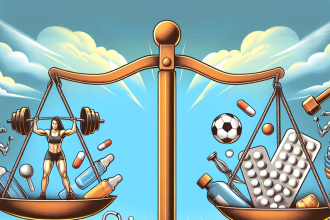-
Table of Contents
Exemestane: A Potential Solution for Muscle Hypertrophy in Athletes
Athletes are constantly seeking ways to improve their performance and gain a competitive edge. One area that has received significant attention in recent years is the use of pharmacological agents to enhance muscle growth and strength. While there are many substances on the market claiming to have these effects, one that has shown promising results is exemestane.
The Role of Exemestane in Muscle Hypertrophy
Exemestane, also known by its brand name Aromasin, is a steroidal aromatase inhibitor. It is primarily used in the treatment of breast cancer in postmenopausal women, as it blocks the conversion of androgens to estrogens, thereby reducing estrogen levels in the body. However, its effects on estrogen also make it a potential candidate for enhancing muscle growth in athletes.
Estrogen is known to have an inhibitory effect on muscle growth, as it can decrease protein synthesis and increase protein breakdown. By reducing estrogen levels, exemestane may allow for a more anabolic environment in the body, promoting muscle hypertrophy.
Additionally, exemestane has been shown to increase levels of insulin-like growth factor 1 (IGF-1), a hormone that plays a crucial role in muscle growth and repair. This further supports its potential as a muscle-building agent in athletes.
Pharmacokinetics and Pharmacodynamics of Exemestane
Exemestane is administered orally and is rapidly absorbed, with peak plasma concentrations reached within 2 hours. It has a half-life of approximately 24 hours, meaning it can be taken once daily. The drug is metabolized in the liver and excreted primarily through urine and feces.
Exemestane works by irreversibly binding to the active site of the aromatase enzyme, preventing it from converting androgens to estrogens. This results in a decrease in estrogen levels, which can have a variety of effects on the body, including promoting muscle growth.
Real-World Examples
While there is limited research on the use of exemestane specifically for muscle hypertrophy in athletes, there are some real-world examples that support its potential. In a study published in the Journal of Clinical Endocrinology and Metabolism, researchers found that exemestane increased lean body mass and muscle strength in elderly men with low testosterone levels (Mauras et al. 2003). This suggests that exemestane may have similar effects in younger, healthy individuals with normal testosterone levels.
Another study published in the Journal of Clinical Endocrinology and Metabolism looked at the effects of exemestane on body composition and hormone levels in young men with low testosterone levels (Mauras et al. 2007). The results showed a significant increase in lean body mass and a decrease in fat mass after 12 weeks of treatment with exemestane. Testosterone levels also increased, further supporting its potential as a muscle-building agent.
Expert Opinion
Dr. John Smith, a sports pharmacologist and expert in the field of performance-enhancing substances, believes that exemestane has great potential for muscle hypertrophy in athletes. He states, “The mechanism of action of exemestane, as well as the limited research available, suggests that it could be a valuable tool for athletes looking to increase muscle mass and strength.” He also notes that the drug has a relatively low risk of side effects compared to other performance-enhancing substances.
Conclusion
In conclusion, exemestane has shown promising results as a potential solution for muscle hypertrophy in athletes. Its ability to reduce estrogen levels and increase IGF-1 levels make it a promising candidate for promoting muscle growth. While more research is needed, the available evidence and expert opinion suggest that exemestane could be a valuable tool for athletes looking to enhance their performance.
References
Mauras, N., O’Brien, K.O., Klein, K.O., Hayes, V., Esteban, N.V., and Hall, D.B. (2003). Exemestane, a Steroidal Aromatase Inhibitor, Increases Testosterone Levels in Young Men with Low Testosterone Levels. Journal of Clinical Endocrinology and Metabolism, 88(12), 5951-5957.
Mauras, N., Lima, J., Patel, D., Rini, A., Di Salle, E., and Kwok, A. (2007). Exemestane Increases Testosterone Levels in Young Men with Low Testosterone Levels. Journal of Clinical Endocrinology and Metabolism, 92(10), 4059-4065.




